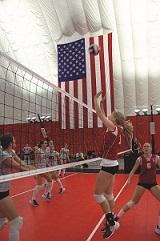
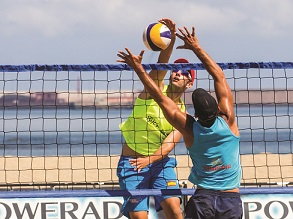
“It’s all part of the fun,” says Mike Minich, president of Southern Events Management, which runs Emerald Coast Volleyball Week and its fall companion, the East Coast Fall Classic. “These folks are athletes, and they are partiers. They take the sport seriously, but they don’t talk themselves seriously.”
Setting aside the partiers, however, volleyball is still different; it’s a lifetime sport, and the social side of the game is more dominant than in many other sports. USA Volleyball is so convinced of the sport’s universal and lifelong appeal that it sponsors national championships in age group categories ranging from 11 and under to 79 and over. Volleyball, at least at the youth level, remains one of the last female-centric sports, and it is the second most popular team sport for collegiate women and the third most popular for high school girls.
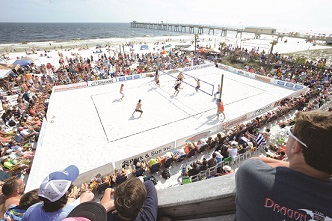
But volleyball also has its challenges. Only 12,000 boys between the ages of 10 and 18 belong to USA Volleyball, for example, compared to 225,000 girls. The need for additional space to host tournaments is becoming more pressing, too; fortunately, cities are rising to meet the demand.
“Volleyball is the most crowded team sport you can pursue,” says John Kessel, director of sport development at USA Volleyball headquarters in Colorado Springs, Colorado. He is referring to the limited amount of space between multiple courts at most tournaments. “That’s why hundreds of dedicated volleyball facilities have popped up over the years.”
In the absence of volleyball-specific venues, convention centers, along with college and high school gymnasiums, fill the void, making the sport nearly ubiquitous in this country.
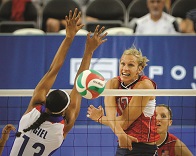
Volleyball as a tournament sport wasn’t always so popular, in large part because there weren’t enough facilities with enough room to host dozens of games at the same time. Most venues were considered prime spots if they could host two simultaneous games.
Then in 1989, USA Volleyball began a partnership with SportCourt, a modular sports surface manufacturer that allows large spaces such as arenas, convention centers and even warehouses to create what would eventually become an indoor volleyball circus. At their most extreme, some USA Volleyball-sanctioned events house more than 100 courts.
Around the same time, the Volleyball Festival — a major event now held at the Phoenix, Arizona, Convention Center that utilizes 107 courts for about 500 teams — introduced the “wave” format. Immensely popular at large-scale tournaments, the scheduling method divides teams into morning and afternoon waves, during which they play multiple matches in a specific timeframe. That leaves players, coaches and parents free to explore a tournament’s location during their downtime.
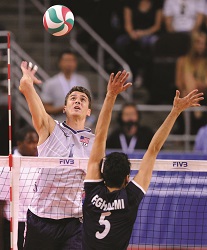
Accommodating the Masses
The above developments laid the foundation to help volleyball become the No. 1 female team sport in the United States, ahead of soccer, basketball and softball. And convention and visitors bureaus know that.
“The sports market has become one of the fastest-growing segments when compared to corporate, government and leisure markets,” says Barbara Wolke, vice president of the Rutherford County (Tennessee) Convention & Visitors Bureau, which recently trademarked the county as ‘The Sports Capital of Tennessee.’ “We host many local, state, regional and national sporting events, including the Tennessee Secondary School Athletic Association High School Volleyball Championships at Middle Tennessee State University’s Murphy Center.”
Wisconsin Dells, Wisconsin, dubbed the “Waterpark Capital of the World,” also attracts plenty of land-based activities — thanks to the presence of The Dells Center and JustAgame Fieldhouse, two multipurpose facilities that have made indoor volleyball tournaments a priority.
 “Volleyball is definitely one of our mainstays,” says Tifani Jones, director of sales for the Wisconsin Dells Visitor & Convention Bureau, which offers grants to organizations that can meet specific criteria. Additionally, when bidding on tournaments expected to make a large economic impact, the Dells will apply for matching funds from the State of Wisconsin to help win the bid.
“Volleyball is definitely one of our mainstays,” says Tifani Jones, director of sales for the Wisconsin Dells Visitor & Convention Bureau, which offers grants to organizations that can meet specific criteria. Additionally, when bidding on tournaments expected to make a large economic impact, the Dells will apply for matching funds from the State of Wisconsin to help win the bid.
As in many sports, CVBs work to secure volleyball tournaments and then let a tournament director take over. That arrangement works particularly well in Abilene, Texas. Since 2008, the city has hosted March’s FrontierFest Volleyball Tournament for girls ages 12 to 18 at numerous high schools that hold up to four courts each. Over time, the number of teams has increased from 40 to more than 60. “We turn the event over to a tournament director, which now allows us to better capture room block information,” says Debi Schultz, director of sales for the Abilene Convention and Visitors Bureau, explaining that widespread use of online travel services such as Travelocity and Orbitz over traditional room block bookings make it exceedingly difficult to capture the number of hotel stays a particular event brings to town. “We want to know how many people stayed, and the organization wants to know how many room blocks were used.”
Abilene asks tournament directors to collect from team coaches how many player families booked hotels using designated room blocks versus how many booked using alternative means. “We require that, and won’t help the tournament next year if it doesn’t provide that information to us,” Schultz says. “This is a two-way street, and the tournament director is right there with all the coaches and can easily capture that information. It’s not totally accurate, but it gives us a better estimate.”
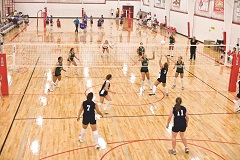
“If you don’t do that, your team might have to pay a higher tournament fee or not play at all,” says Katy Tigchelaar, the commission’s events manager, adding that the first tournaments for which the new policy will be enforced are the 2015 Lakeshore Volleyfest and the 2015 Michigan Junior Volleyball Association Championship/AAU Grand Prix, both in Grand Rapids.
“I think volleyball has been late to this concept compared to other sports,” Tigchelaar says. “People were afraid teams wouldn’t sign up. But it’s catching on now and becoming the norm.”
Sand on Solid Ground; Boys Not So Much
Sand volleyball, as its quick ascension up the NCAA ranks suggests, also is catching on. That’s why events such as Emerald Coast Volleyball Week (with more than 300 teams this year), the famous six-man tournament in Manhattan Beach, California, and numerous other tournaments — including the American Volleyball Coaches Association’s Collegiate Sand Volleyball Championships at Gulf Shores Public Beach in Alabama — have gained increasing popularity.
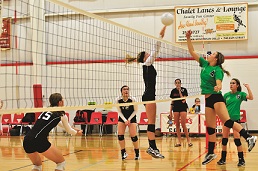 “This makes the sport even more exciting for the current and future teams participating,” says Beth Gendler, vice president of sales for Gulf Shores & Orange Beach Tourism. “It should also drive the sport at the high school level, as all the universities will need and be seeking great high school talent for sand volleyball.”
“This makes the sport even more exciting for the current and future teams participating,” says Beth Gendler, vice president of sales for Gulf Shores & Orange Beach Tourism. “It should also drive the sport at the high school level, as all the universities will need and be seeking great high school talent for sand volleyball.”
This is especially true if the United States wants to further the strong showings in men’s and women’s beach volleyball at recent Olympics. But in order for that to happen, more boys will need to join the ranks.
“The hard part is getting boys to realize that volleyball is a sport,” says Caleb Sturrup, volleyball club and tournament director for Geneva, Ohio’s SPIRE Institute, one of the largest indoor multisport training and competition complexes in the world, with more than 750,000 square feet of space. “It’s not as macho as football or basketball, so it seems like a lot of men miss out on the sport as a kid. But at age 35 or 40, they’re not playing football anymore, so they give volleyball a try.”
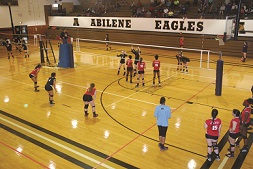
The USA Volleyball Boys’ Junior National Championships, held in a convention center with as many as 45 courts, spans eight days and has grown from 204 teams in 1996 to more than 450 in 2014. Once held simultaneously with the Girls’ Junior National Championships, the boys’ event has operated as a stand-alone tournament for the past decade.
World Series of Grass Volleyball
Grass volleyball may not be as commonly known or accepted, but its participation numbers trail beach volleyball by fewer than 500,000 (4.5 million to 4.08 million, according to USA Volleyball).
Credit some of that to the success of the Waupaca Boatride Volleyball Tournament, which began in a state park in Waupaca County, Wisconsin, in 1983 and took its name because a local bar traditionally offered paddlewheel boat rides after the tournament. In the early days, the event attracted 100 people or so; today, it’s held in Oshkosh, Wisconsin, where more than 4,000 players and 1,050 teams converged on 230 acres of farmland and golf course fairways this past July. (Thirty to 40 more courts are expected to be added for 2015, bringing the total close to 250 courts. Other popular grass volleyball tournaments include the Pottstown Rumble in Pennsylvania and the King & Queen of the Grass Tournament in Maryland.)
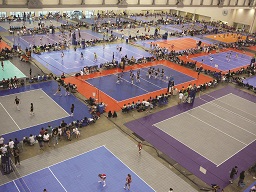
But what really separates this event from other tourneys is the absence of referees. “Strangely enough, we do not use officials, and never have for more than 30 years,” Galecke says. “Everyone’s always mystified by this, but volleyball comes close to golf in terms of unspoken rules. Players make all the calls based on the honor system. It doesn’t take away from the competitive aspect.”
A Sport Unlike Any Other
The fact that the Waupaca Boatride Volleyball Tournament can survive for as long as it has with players policing themselves speaks volumes about this sport. (It is difficult to imagine adult participants in basketball or hockey tournaments calling their own penalties.)
“Volleyball has developed as an alternate noncontact sport to basketball,” Emerald Coast Volleyball Week’s Minich says, with the emphasis on “noncontact.” “Respect for the other teams and the people around you is paramount. We’ve kicked some people out of our events. If you’re a participant, and your good time interferes with someone else’s good time, you need to re-evaluate.”

